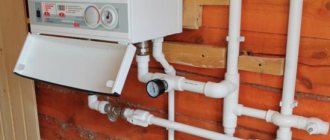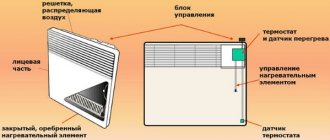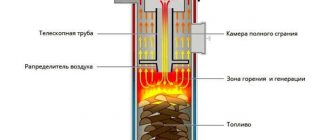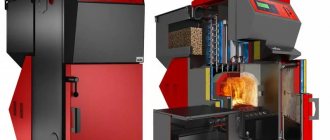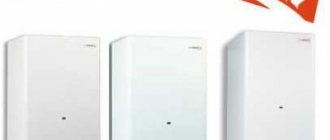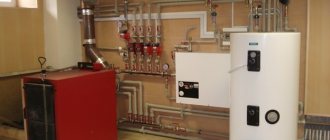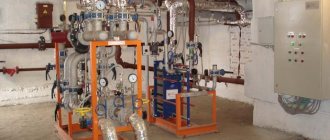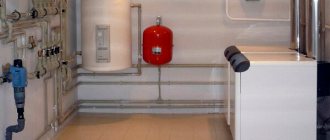“Buying an electric boiler is not profitable.” This myth is refuted by the fact that manufacturers are releasing more and more models of different configurations to suit any consumer request. In the absence of an alternative, heating with electricity becomes a profitable solution. You just need to choose the equipment correctly, install it correctly, and adjust the work. Let's talk about it here. And again, we will build on your wishes.
Why is an electric heating boiler better than a gas one?
Despite the fact that gas is a cheaper source of energy than electricity, installing gas equipment is not always preferable. The main obstacles to installing a boiler of this type are:
- Difficulties with obtaining permission, coordination and preparation for installation. The room must have a properly organized ventilation system and removal of combustion products.
- High cost of equipment and labor intensive installation. And if we are talking about a private house where gas is not supplied, then the costs increase significantly.
- Potential danger of the fuel itself and its combustion products.
Advantages of electric heating systems
Electric boilers have many advantages, including:
- High reliability in terms of fire safety (of course, subject to the availability of high-quality wiring and fuses).
- Low installation costs, easy installation.
- Wide price range, choice of functions. In general, electric models are cheaper than gas models. You can choose a simple boiler, consisting of a set of heating elements and a primitive control system, which will cost very little. If there are no financial restrictions, you should pay attention to automated devices. They are able to maintain a given temperature with minimal energy consumption and have several programming modes, a GSM controller that allows you to regulate the operation of the device from a distance, and other useful options.
- Compact and aesthetically pleasing. In many modern models, all the necessary elements - a circulation pump, an expansion tank, an air vent, protection systems - are hidden inside the housing. If desired, the electric boiler can be installed in any room of the apartment. The most common are wall-mounted varieties.
- Ease of use. To control the device you only need to press a few buttons. Electric boilers do not require control or participation in their operation.
- Silence. The owners can only hear the quiet hum of the induction device or the hum of the automation units.
- There is no need for coordination with relevant organizations when the device power does not exceed 9 kilowatts.
- High efficiency.
Advantages and disadvantages
The first question that worries any buyer is why should you consider this option? Is it better than other heating boilers?
Electric heating boiler - assembled system with external pumps
pros
Electric boilers:
- compact, light weight;
- easy to install, easy to connect and use;
- attractive in appearance;
- no need to make a chimney;
- work silently;
- cost less than gas, diesel and solid fuel boilers (from 9,000 rubles for a low-power device);
- safe, no open flame, switches off automatically in case of failure (for example, no water);
- can work without human supervision;
- can be used as a backup heat source;
- have high efficiency;
- do not require storing fuel;
- will last a long time;
- wide choice of models (for example, power - from 2 to 500 kW).
A misconception is that antifreeze cannot be used with electric boilers. This is quite possible in models where thermo-chemical gaskets are used for the brass nut (into which the heating elements are soldered).
Minuses
To objectively evaluate the option, you need to weigh the problems that may arise with the electric boiler:
Expensive kilowatt-hour. Only wealthy people can afford to completely heat themselves with electricity. In fact, it turns out that a season on electricity can be 2 times more expensive, compared, for example, with solid fuel.
The fact that this type of heating makes the house dependent on the supply of electricity is also not attractive. Sometimes I turn off the lights as planned, and accidents occur on the line. Wires are rarely stolen, but still. Being left without heating in the middle of winter, even for a day, is extreme.
Heating with electric boiler
Other difficulties:
- Networks do not provide sufficient power everywhere;
- Water circulation should be at level. If it is insufficient, the boiler may boil or shut down.
Considering the above, the use of electric boilers is advisable:
- In apartments where there are problems with heat supply, as auxiliary heating;
- in small well-insulated houses, especially if the owners periodically leave the house;
- in areas with mild climates, as the simplest way to organize heating;
- complete with a heat accumulator, if electricity costs less at night.
Disadvantages and difficulties of operating electric boilers
The advantages of electric boilers look very attractive. But they also have disadvantages, and very significant ones.
- High cost of electricity.
Note! Costs can be reduced several times by insulating the apartment, using preferential electricity tariffs and choosing a device with precise adjustment.
- Requirements for the type of radiators. In an electrically heated system, it is uneconomical to use cast iron and steel batteries. It is advisable to choose bimetallic or, as a last resort, aluminum heating devices.
- Complete dependence on power supply.
- Demanding on the quality and composition of the coolant.
- When installing equipment that consumes more than 9 kW, instead of a standard 220 V network, a three-phase 380 V network will be required. If the apartment does not have one, you must obtain a special permit for the installation, which is not always possible in old houses.
Before you decide to purchase and install an electric boiler, you need to weigh all the pros and cons, calculate the approximate electricity consumption per month and think about how significant it will be for the budget.
What features do electric boilers have?
Naturally, electric boilers for heating a private home differ according to some criteria. At the same time, they also have some common properties.
The following features of electric boilers can be distinguished:
- Only low-power heaters with a power of up to 3.5 kW are allowed to be connected to a regular outlet. A simple calculation will show that by multiplying the 16 amperes indicated on any outlet by 220 volts, we get the maximum permissible power of 3520 watts.
- Single-phase boilers have a maximum power of 12 kW. However, in reality, it is advisable to connect devices over 7 kW to 380 volts.
It is worth noting that in order to connect the boiler, you need to run a separate copper cable from the panel, with a cross-section of more than 1 millimeter for every 8 amperes of peak current.
- All expended electricity is fully transformed into heat, so such electric boilers have 100% efficiency.
However, there are designs of electric boilers for heating a private house, in which, during the heating process, part of the energy is lost on the body, but even this will be used to heat the interior space of the room.
That is, when choosing a boiler, you should pay attention to durability, functionality and safety, but not to efficiency.
- Most often nowadays they try to save on electricity, since it is the most expensive source of heat. So get ready for big energy bills. Be that as it may, it is the safest and most convenient source of thermal energy.
Electric boilers with heating elements (tubular heaters)
Such boilers work on the same principle as most household electrical appliances - kettles, boilers, irons. They are most in demand among consumers and are presented in a wide variety of models. There can be several heating elements, and they are turned on together or alternately.
Pros:
- simplicity of design;
- reliability of the circuit, ease of repair.
Minuses:
- high inertia of boilers - slow heating at startup;
- demands on the quality of the coolant. The tendency for scale to form, which reduces heating efficiency, forces special measures to be taken. You can install anode rods that will collect salt deposits on themselves, and change them at certain intervals, just like the heating elements themselves. But it is better to use specially prepared water or a special coolant.
No. 6. Power regulation and boiler control system
In electric boilers, it is enough to simply regulate the power and temperature of the coolant. Actually, these two parameters are interrelated, so it is impossible to consider them separately from each other.
The boiler power is adjusted in one of the following ways:
- stepwise - a common option in heating element boilers. In this case, the design provides one heating element, which provides half the power, and two, which provide 25% heating each. It turns out that the boiler can operate at 25, 50, 75 and 100% of the maximum power; more precise adjustment can be made in each room thanks to the valves on the radiators;
- Smooth adjustment is achieved through the use of a rheostat. This is a privilege of more expensive models. In simple low-power boilers there may be no adjustment at all.
The user sets the boiler the required coolant temperature to maintain comfortable conditions in the house, and the boiler turns on the heating and turns it off when the coolant is sufficiently hot. Automation can work using mechanical and electronic thermostats. Both options allow you to save energy and maintain a comfortable temperature without constantly monitoring the boiler.
A mechanical thermostat cuts off the coolant flow or opens the electrical network when the user-specified coolant temperature is reached. When the temperature drops, the boiler turns on again. This is a simple and cheap method, but not the most accurate - the coolant temperature at the boiler outlet may differ by 2-30C from the set one. Electronic thermostats are more accurate; they consist of a remote sensor and a control unit. The sensor is attached to the heating element and transmits information about its temperature to the unit remotely or using wires. Naturally, such boilers are more expensive.
Induction devices
Induction boilers are energy-efficient and reliable devices that can operate for years without maintenance or repair.
Pros:
- thanks to the phenomenon of self-induction, they significantly save energy (up to 30% during the heating season);
- undemanding to the composition of the coolant (scale does not appear in such boilers);
- service life - from 30 years, the likelihood of breakdown due to the design features is very low;
- quick heating of the coolant;
- possibility of precise adjustment.
Minuses:
- large mass (from 30 kg) - strong brackets are used for hanging, the wall must be able to withstand the load;
- circulation pump, expansion tank, safety group are purchased and installed separately;
- relatively high cost;
- vibration noise during operation.
Installation procedures
To hang the device, you need a mounting plate, which is included in the delivery package: it is attached to the wall with four dowels or anchor bolts with mandatory horizontal and vertical alignment. If this is a floor-standing boiler, then it is installed on a special stand.
The device must be grounded, inspected and made sure that it is in the correct position, the water pressure in the system is normal, and all communications are connected.
Electric heating units must be connected with a wire whose cross-section is indicated in the documentation for the equipment. Wires are carried in special protective boxes.
Scheme options
There are various diagrams: a diagram for connecting an electric boiler with heating radiators, diagrams with the possibility of installing a cascade. The latter option is used if it is necessary to heat large areas. To operate devices in a cascade, the terminals of the control unit are connected to the terminals of the controlled unit. If the installation system is controlled by a room regulator, then its control contacts are connected to the terminals of the leading equipment.
Heating apparatus piping
Tying can be carried out using a direct or mixing scheme. The direct scheme involves adjusting the temperatures with a burner, the mixing scheme involves a mixer with a servo drive. The binding is carried out as follows. The boiler manifold is installed, a pipe of the required diameter is connected to the boiler.
A three-way mixing valve is installed at the inlet, which will regulate the temperature. A circulation pump is installed on the return line and a control unit is mounted. After piping, you can fill the system with coolant and test the operation of the equipment for correctness.
Do not underestimate this stage: in reality, it is not as simple and insignificant as it might seem. Normal piping allows you to use equipment without an automation system, and this greatly reduces costs. Therefore, it must be performed at a professional level and taking into account the design features of the system and boiler.
The wiring of an electric boiler must be done by a specialist. If you still have to do it yourself, then you need already assembled distribution units. General diagram of the implementation of a heating system in a house.
Ionic (electrode) heating boilers
Such devices heat the coolant by applying voltage through the electrodes, resulting in the ionization of molecules and their movement towards a conductor with a different polarity. In a single-phase network, one electrode is used in the form of a rod, the second is the surface of a metal cylinder, with three-phase voltage - 3 electrodes.
The sizes of ion boilers vary from very small ones, capable of heating only one battery, to large installations designed for a large house. Available both with and without casing.
Pros:
- compactness. The device without a housing takes up little space;
- high-speed heating of the coolant;
- low inertia, allowing very precise adjustment;
- resistance to voltage surges;
- high level of safety - if there is no coolant in the boiler, it simply cannot work;
- low price (without control unit, pump and expansion tank).
Minuses:
- complete incompatibility with batteries made of steel and cast iron;
- demands on the quality of the circulating fluid, which must have a balanced composition. It is recommended not to make it yourself, but to purchase a ready-made one;
- the need for a specialist to check the condition of the coolant before the new heating season;
- special requirements for the grounding loop;
- heating temperature – no higher than 75 °C;
- the need to replace electrodes at certain intervals.
Electric induction boilers
The working part of an induction heating electric boiler for a private house consists of a dielectric pipe, inside of which there is a core. The coolant moves through the pipe. A coil is wound from the outer part. Passing through it, the current heats up the core.
Such devices have two positive qualities:
- Small dimensions . High-power models can only slightly differ in thickness from the heating circuit, with a length of up to 1 meter.
- Unsurpassed reliability . In such a boiler there are practically no elements that could break, with the exception of the electronic control unit, which is most often installed outside the housing.
The only significant drawback of induction electric heating boilers for a private home is their very high cost. To be fair, it is worth saying that the manufacturing technology of such devices is no more complicated than with conventional heating elements. And the pump and safety systems are located outside the boiler body. So the reason for the high cost is rather marketing than due to the peculiarities of production.
Single-circuit and double-circuit boilers: what is the difference?
Let's look at the differences between the two modifications of these units.
- Single-circuit boilers are designed only for heating the room. At the same time, an indirect heating boiler can be connected to all modern boilers and hot water supply can be provided.
- Double-circuit, in addition to participating in the heating system, heat water for domestic needs. Their design provides an additional heat exchanger, which can be flow-through or storage - in the form of a built-in water heating tank.
Note! A double-circuit boiler cannot operate on 2 circuits at the same time. When you open a hot water tap, heating of the heating fluid stops.
Let us briefly describe their advantages and disadvantages.
Advantages of a single-circuit boiler:
- relatively low cost;
- high efficiency and high power;
- lower energy consumption (no boiler).
Minuses:
- if necessary, you will have to install an additional boiler to heat water;
- together with an indirect heating boiler, the design looks bulky and unaesthetic.
Advantages of a dual-circuit device:
- quite compact size;
- easy installation.
Minuses:
- instability of water pressure and temperature;
- high requirements for coolant quality and maintenance;
- high cost.
Note! If we compare the prices of a double-circuit boiler and a device with one circuit and an additional boiler, the first will cost less.
It's difficult to say which boiler is better. If it is important to save energy, as well as space in the apartment, you should choose a double-circuit version. This device heats water only when it is needed; the single-circuit device will turn on every time the liquid cools down. At the same time, a single-circuit boiler is considered more reliable and convenient to use.
Advice. If your automated boiler has an additional storage tank, it can be programmed to heat water at night when electricity rates are lower. During the day, when the cost of electricity is higher, you can use already heated water.
How to choose an electric boiler for heating a private house
Single-circuit or double-circuit
Single-circuit electric boilers heat the coolant in one circuit - the heating circuit. Double-circuit ones are designed for both heating and hot water supply (DHW). In this case, sanitary water from the DHW circuit does not mix with technical water from the heating circuit.
Double-circuit electric boilers cost only 10-30% more than their single-circuit counterparts and are the most cost-effective way to organize hot water supply at home. However, they are popular only with owners with a relatively unlimited budget, since expensive electricity is also spent on preparing sanitary water.
Single-phase or three-phase power supply
Low-power models up to 6 kW inclusive operate from a standard single-phase network (220-230 V). More and more powerful models require the organization of a three-phase electrical network; this should be taken into account before purchasing an electric boiler. Otherwise, the power of a single-phase network will simply not be enough, the boiler will not be able to provide maximum heating output, the water will take longer to heat up to the set temperature, and in severe frosts the heating output may not be enough at all.
Additionally, information about electrical requirements is always indicated in the technical specifications of the model.
Automation functionality
The most inexpensive models of electric boilers operate on the “On/Off” principle. We recommend choosing electric boilers with at least 3-stage power control, and better yet, with degree-by-degree temperature control. Even greater efficiency can be achieved by electric boilers with a built-in programmer, which allows you to set operating parameters for the next day or week. This way you can set the temperature to 15°C during working hours when the owners are not at home. Also set the temperature to 18-19°C during sleep or, conversely, heat the house more actively at the night electricity tariff if a multi-tariff meter is installed.
However, the built-in programmer is not present in all even expensive models. But almost all modern electric boilers allow you to connect external control, for example, a room thermostat - the most economical and comfortable option of all existing ones. A technologically advanced electronic room thermostat with programmability allows you not only to implement what was described earlier, but also to make more accurate measurements, focusing on the air temperature in the room, and not the temperature of the coolant.
How to choose an external thermostat for an electric boiler and save up to 30% on heating every month
Also in modern models it is possible to support weather control, when the automation adjusts the operation of the boiler to external weather conditions. If the boiler is planned to be installed in a temporary home, frost protection is mandatory to prevent icing and damage to the heating system lines. However, we do not recommend overdoing it with options that are not useful; it is better to find a middle ground. The minimum functionality required for comfort and efficiency is degree-by-degree temperature control, the ability to connect external control or a built-in programmer.
Minimum required power
In practice, the required power is usually calculated in a simplified form, based on the rule: for an average house in the Moscow region with 2 bricks and a ceiling height of up to 2.7 m, 1 kW of heating equipment power is required for every 10 m2 of area. We also recommend setting aside a 15-20% power reserve; for heating electric boilers - up to 30% reserve (more on this later). If the boiler is double-circuit, we recommend adding another 10% power reserve on top.
For example, for a house with an area of 120 m2, the minimum required power of a heating element single-circuit electric boiler is 120/10 * 1.3 = 15.6 = 16 kW.
This method is sufficient in more than 95% of cases. If the house is well insulated, is located in the extreme southern or, conversely, in the extreme northern point of the country, has high ceilings and a large glazing area, it is necessary to make a more accurate calculation taking into account correction factors. You can make a more accurate calculation using the calculator below (for each room separately, then summed up), or better yet, by involving a heating engineer.
Power
The power of the boiler is its most important characteristic, which means you need to choose it correctly. Sometimes it is tied to the footage and calculated based on the value of 1 kW per 10 m2. This formula is only suitable for a very rough estimate.
In fact, you need to focus on heat loss. If, for example, they are 8 kW, then you need a boiler of the same power. The calculations take into account:
- area and height of the room;
- degree of insulation of walls, floors, ceilings;
- the number of external walls and their location according to the cardinal directions;
- number, dimensions and type of windows;
- battery connection diagram;
- region of residence and other parameters.
To correctly calculate the boiler power, it is recommended to use special calculators or seek advice from a heating engineer.
Installation of an electric heating boiler, connection to power supply
In addition to the plumbing connection of the electric boiler (piping), the most important task when installing an electric boiler is to correctly connect the electric boiler. As they say, this work should be done by professionals, but you will find information on this issue useful.
- For an electric boiler, you need to allocate a separate power supply line from the input distribution board of your home;
- The boiler's power supply line must be protected by a circuit breaker with a rated operating current slightly greater than the operating current of the electric boiler at maximum mode (this data is in the boiler's passport);
- The body of the electric boiler must be grounded by the third (220 V) or fifth (380 V) wire in the power cable. Separate grounding wires cannot be used to ground the electric boiler;
In the input distribution device (IDU) at home or the electrical panel at home, the boiler power supply cable is connected as follows:
- Phase power supply wires L1;L2;L3 are connected to the output terminals of the three-phase circuit breaker. The circuit breaker is separate, only for the electric boiler.
- The neutral working wire (N) is connected to the neutral bus (terminal block) of the shield;
- The grounding wire is connected to a separate bus in the panel marked “Earth”.
- With a single-phase (220 volt) power supply to the boiler, the three-pole circuit breaker is replaced with a single-pole one. The remaining connections remain unchanged.
Important! Do not confuse or combine the connection of the neutral working (N) and grounding, protective (PE) wires when connecting a three-wire and five-wire electric boiler.
Additional functions
The following functions of electric boilers may be useful:
- protection systems – from overheating, short circuit, overpressure;
- the ability to install a GSM controller, which will allow you to remotely adjust the temperature in the apartment, change the boiler settings, and send notifications about possible problems;
- a control unit with energy-saving modes that allow you to reduce the temperature at certain periods of time - at night, when residents are not at home;
- smooth power adjustment. This option is more convenient and profitable than the stepped one.
Note! Often control units are not included in the package of electric boilers. In this case, they will have to be purchased separately.
What affects electricity consumption
All boilers convert the energy used into heat in a 1:1 ratio. With 100% efficiency, negligible losses in wires and connections are neglected. The exception is heat pumps, but they are still rarely used.
Thus, there are only 2 ways to reduce electricity consumption:
- Reduce heat loss. To do this, the home is covered with mineral wool or polystyrene foam, and the cracks are sealed.
- Optimize the operation of the boiler in order to eliminate excessive consumption of energy resources.
The second problem is also solved in 2 ways:
- Using weather-sensitive automation. Such a system promptly warns the boiler about the onset of warming, and it manages to reduce power without overheating the room.
- Programming. A model with this function, according to user settings, reduces heating output when residents are at work or sleeping. The rest of the time the device returns to normal mode.
For inexpensive heaters, the first option is not suitable. They do not have the function of connecting weather-compensated automation. Then it is recommended to install at least a remote thermostat: it maintains the room temperature at a given level.
It is possible, without reducing consumption, to reduce financial costs. They are switching to differentiated metering of electricity consumption with a big discount at night (RUB 1.68 instead of RUB 3.89). The heating system is equipped with a heat accumulator - a large capacity in which the boiler raises the temperature of the working environment to +98˚C within a grace period. During the day, boiling water is gradually supplied from it through the mixing unit into the circuit as needed; the heater does not work at this time.
In this case, you will have to pay 17,388 × 1.68 = 29,212 rubles for the season. But there is a nuance: the rated power of the boiler should be twice the design power, because at night it works both for heating and for “charging” the heat accumulator. For the example given, a 20 kW unit will be required.
Popular models
Among the variety of brands, the leading positions in the ranking are occupied by the following manufacturers:
- Protherm (Slovakia),
- Vaillant (Germany),
- Kospel (Poland),
- Buderus (Germany).
Among Russian brands, buyers give preference to 3 brands:
- "EVAN"
- ZOTA,
- "RusNIT".
The best models from the category of medium-power boilers that are suitable for apartments, based on user reviews:
- RusNit 208M (average price - 16 thousand rubles);
- EVAN Warmos-IV-5 (16.5 thousand rubles);
- ZOTA 12 Lux (RUB 21.4 thousand);
- Kospel EKCO L2 12 (37 thousand rubles);
- Protherm Skat 12 KR 13 (32.5 thousand rubles);
- Vaillant eloBLOCK VE 12 (35 thousand rubles);
- Buderus Logamax E213-10 (9.3 thousand rubles).
Sections of electrical cables for power supply of electric boilers
I will give an example of the ratings of circuit breakers (Table 2) and the cross-section of supply cables (Table 1) for electric heating boilers.
Table 1
Sections of power cables for electric heating boilers
| Boiler power | Cable cross-section for single-phase electric boilers | Cable cross-section for three-phase electric boilers |
| up to 4 kW | 4.0 mm2 | |
| up to 6 kW | 6.0 mm2 | |
| up to 10 kW | 10.0 mm2 | |
| up to 12 kW | 16.0 mm2 | 2.5 mm2 |
| up to 16 kW | 4.0 mm2 | |
| up to 22 kW | 6.0 mm2 | |
| up to 27 kW | 10 mm2 | |
| up to 30 kW | 16 mm2 | |
| Up to 45 kW | 25 mm2 | |
| Up to 60 kW | 35 mm2 |
table 2
Ratings of circuit breakers for the power supply line of an electric boiler
| Boiler power | For single-phase electric boilers | For three-phase electric boilers |
| 4 kW | 25 A | 10 A |
| 6 kW | 32 A | 16 A |
| 8 kW | 40 A | 16 A |
| 10 kW | 50 A | 20 A |
| 12 kW | 63 A | 25 A |
| 14 kW | 25 A | |
| 16 kW | 32 A | |
| 18 kW | 32 A | |
| 22 kW | 40 A | |
| 27 kW | 50 A | |
| 30 kW | 63 A | |
| 45 kW | 80 A | |
| 52 kW | 100 A |
What it is?
An electric boiler is a heating device that provides the preparation of coolant for a heating circuit or underfloor heating system.
This is a device that is usually used when it is not possible to supply gas to the house, or to use a boiler of a different design.
This approach is due to high electricity prices and experience in using other heating electrical appliances - kettles, irons, etc. At the same time, modern models can operate in a fairly economical mode, and the absence of other sources of thermal energy (gas, solid or diesel fuel) allows reducing costs to a minimum.
Manufacturers of electric boilers
Among the most famous and reliable manufacturers of electric boilers are the following companies:
(Germany, Slovakia)
(Germany)
(Slovakia)
(Russia)
(Russia)
(Russia)
The list can be continued for a long time, but for a correct understanding it should be taken into account that the choice of an electric boiler should not be made based on the brand name. Technical characteristics, power, type of heaters and other important parameters are important here.
For work in Russian conditions, products from domestic manufacturers are much preferable. They are well familiar with the features and operating conditions, so the use of Russian electric boilers will allow you to do without expensive add-ons (imported UPS, expensive spare parts, etc.).
Types of heaters for direct electric heating of the house
Since the key elements for any direct electric heating systems are heaters, it is necessary to get at least a little familiar with the devices on our market.
This equipment is classified according to several criteria, the main one being the heat transfer method.
For example, radiant and convective heaters.
Radiant heaters include infrared panels and mirrors that emit heat.
And devices whose operation is based on convection are electric convectors, air heaters and heat fans.
To those listed above should be added the following types of heaters - combined, convective-radiation, as well as electric heaters, the operation of which is based on “indirect heating”.
Will an electric boiler really be useful?
In modern conditions, gas is not accessible to everyone. Some settlements are located far from the main highway. And at times, purchasing and installing a gas boiler makes no sense at all.
For example, for a country house, which is not used very often, it is not advisable to use expensive gas equipment. And boilers that use solid fuel have many disadvantages. For example:
- Most of these units cannot operate on one load for more than five hours;
- There is no way to control the heating temperature;
- Fuel must be prepared ahead of time and in large quantities.
If you take all this into account, then an electric boiler for a private home will indeed become a good and more reliable option.
The main advantages of an electric boiler:
Electric boilers take up less space. Electric boilers can be installed anywhere you like because they don't have a chimney that needs to be routed through your home. There is no mandatory condition to install an electric boiler for heating a private house near an external wall.
An electric boiler for heating a private house can be located in the center of the cottage or in any other place that you really like. An electric boiler does not require a fuel tank, like oil or propane units. This means you save space that would normally be devoted to fuel.
Advantages of an electric boiler:
- High degree of automation;
- It does not require a separate room;
- It is possible to control the heating temperature;
- Easy and fairly quick installation, simple connection and maintenance;
- Can be mounted even on the wall, without outside help;
- Doesn't make noise;
- There is no need to connect it to the chimney.
Electric boilers are safer than gas boilers. You won't have to worry about gas leaks in your home when you rely on an electric boiler. For this reason, these devices are completely safe and can be placed outside your home. They are not that difficult to install. You will feel safe as the heating system will provide the necessary amount of heat without causing any problems.
Cons of electric boilers
While electric boilers have quite a few advantages, there are some disadvantages to using these hydronic heating systems in your home. Electric boilers can potentially cost more than gas boilers. An electric boiler also limits the amount of hot water it can produce. And most importantly, electric boilers leave you at the mercy of the power companies in the event of a power failure.
- If the boiler power is over nine kilowatts, keep in mind that they are produced only for a three-phase voltage of 380 watts;
- A separate cable is required to connect to the meter;
- You have to pay more than usual due to the high electricity tariffs.
Electricity is simply more expensive than gas in most regions of Russia. This means that by relying on electricity to heat your water and home, you'll end up spending more money. Even if your device consumes electricity more efficiently than a gas boiler. In most cases, the financial costs are higher to generate the same amount of heat.
Using double tariff
When using an electric boiler as the main source of thermal energy, you can save on bills by installing a two-tariff meter.
There is a special electricity metering system in which at night the tariffs for electricity consumption are reduced (up to 4 times). This is a good way to reduce costs, but you will have to slightly change the operating mode of the boiler.
At night, water is heated, which maintains its temperature while in a thermally insulated container. During the day, hot water is used for household needs, and at night its supply is replenished again.
It is necessary to take into account that this option is only good for double-circuit boilers that simultaneously heat both the coolant and hot water. For single-circuit models, this method gives too little effect, and given the high cost of the meter, there may be no savings at all. In addition, tariffs differ in different regions, therefore, before deciding to use a two-tariff meter, it is necessary to calculate the possible savings and decide whether this idea makes any sense.
Zuzako editors' recommendations for choosing electric boilers for heating your home
There is a lot of speculation surrounding electric boilers due to their high cost and frequent breakdowns. But in fact, if you choose the right device wisely and use it correctly, you won’t have any problems.
When looking for an energy-efficient model, do not forget to pay attention to its key parameters:
- dimensions;
- installation method;
- performance;
- efficiency indicator;
- temperature adjustment;
- noise level;
- presence of automation.
Manufacturing companies
The most popular boilers today are those produced by:
- Buderus is the most famous and sought-after brand specializing in the production of electrical, gas and solid fuel appliances;
- Kospel is a famous Polish brand that introduces innovative technologies into its products;
- Protherm is one of the most recognizable brands on the domestic market;
- Vaillant is a European company whose products are famous for their impeccable quality and versatility;
- ZOTA is a domestic brand that produces easy-to-use energy-efficient boilers;
- Dakon is a well-known Czech company that has long won a leading position in the field of heating equipment;
- ARISTON is a company that requires no introduction;
- RusNit is engaged in the production of unpretentious boilers of decent quality.
All these brands have proven themselves well and have gained an impeccable reputation.
Power, equipment and efficiency of models
The power of the electric boiler must correspond to the area of the house. The easiest way to calculate the optimal indicator is by the formula: per 10 sq.m. 1 kW power required
In addition, it is important to take into account heat losses that occur due to doors, windows and lack of insulation
Various models of electric boilers can be equipped with expansion tanks, circulation pumps, thermostats and other useful devices. Don’t forget to also check the possibility of connecting a boiler and heated floors, if, of course, you are interested.
The key characteristic that determines the energy efficiency of a boiler is efficiency. Even with similar parameters, different models can have significant differences in terms of efficiency. Often, more expensive boilers in practice turn out to be more profitable and promising than budget appliances, thanks to optimized consumption, which allows costs to be kept to a minimum.
Electric "warm floor"
The heat source in such a field is a special cable built into it.
As a result, the floor turns into a large heating panel that distributes heat evenly throughout the room.
“Warm floor” allows you to create and maintain optimal air temperature.
In addition, such a home heating system does not require additional equipment in the form of radiators, which greatly facilitates the arrangement of furniture and can be used with any floor covering.
Fan heaters
Another effective device for heating a room are fan heaters, which not only maintain a given temperature, but are also able to raise it in a minimum time.
In addition, they can create an air-thermal curtain.
Their undoubted advantage is minimal heat losses and high efficiency.
Today you can see a huge number of fan heaters of varying power and quality on sale.
They are sometimes equipped with air filtration equipment.

